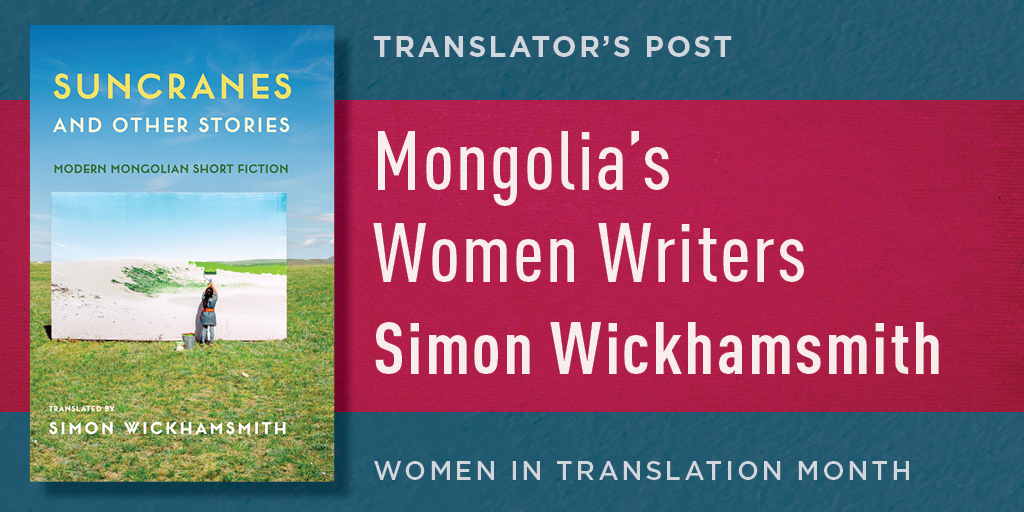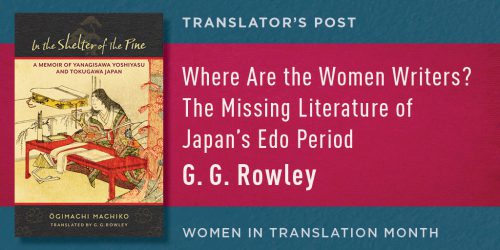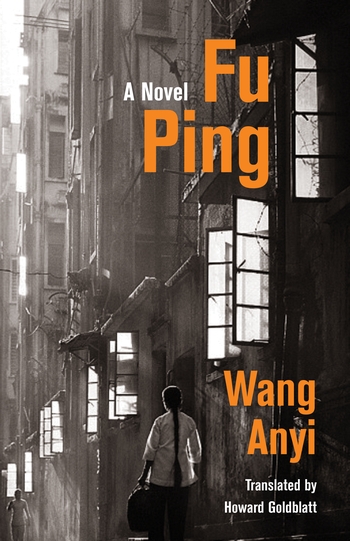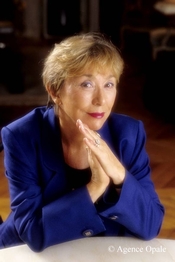Mongolia’s Women Writers
By Simon Wickhamsmith

Since the Soviet-backed 1921 revolution, Mongolia’s writers have worked to find responses both to traditional genres and themes and to the Russian and Euro-American styles, and the three women writers whose work is translated in Suncranes and Other Stories—S. Udval (1921–1991), L. Ölziitögs (b. 1972), and H. Bolor-Erdene (b. 1975)—offer a number of entry points into an understanding of these developments.
By the time she wrote “He Came With a Spare Horse” in the late 1960s, Udval was a high-ranking official of the Mongolian People’s Revolutionary Party and secretary of the Writers’ Union. In her fiction, as evidenced by this story, she appears to have been less motivated by the party’s ideological concerns—adherence to which, though no longer a matter of life and death, was still important in terms of social status and political acceptance—and more interested in the details of her characters’ personal interactions and daily life. That she sets her story at tsagaan sar, the traditional lunar new year celebration, allows her to narrate for her own generation as well as for younger readers, incorporating aspects of the older, more traditional, ways of life alongside the more modern, lived experience of socialism. This, together with the skillful weave of her shy narrator’s crush on his neighbor Ariunaa and the quotidian tension between the generations, is what I think still makes Udval’s work appealing to modern readers.
…Mongolian literary culture was more accepting of the kind of youthful rebellion portrayed here, and such black humor, surrealist imagery, and open discussion of sex had become rather less shocking.
During the late 1980s, and following Mikhail Gorbachev’s successful implementation of perestroika and glaznost, Mongolian writers began to explore foreign literature in a new way, including formally innovative and thematically varied approaches. L. Ölziitögs was one of the leaders of this group and attracted considerable attention at the time as a young woman pushing against the boundaries of fiction. Her story “Raul and Raul” uses an episodic narrative style—rather like brief movie vignettes—with an absurdist humor to tell the strange story of a young man’s coming of age. By 2001, when Ölziitögs wrote the story, Mongolian literary culture was more accepting of the kind of youthful rebellion portrayed here, and such black humor, surrealist imagery, and open discussion of sex had become rather less shocking.
H. Bolor-Erdene, who now lives in Paris, has worked to develop her own independent voice, neither explicitly innovative nor explicitly traditional and, while not as well-known as her near-contemporary Ölziitögs, has developed a following for her slightly claustrophobic and dark tales. Her story “Room for Rent” might be about a haunting or about an unnamed student’s descent into insanity, but it is told with a deftness that belies its feeling of oppressive strangeness.
…that work by Mongolia’s women writers will be read but also that their particular perspective will be visible.
Strictly speaking, these are not the first stories by Mongolian women writers to have been published in English translation (there is one story by Udval’s contemporary E. Oyuun in a collection published in Mongolia in 2005), just as Suncranes is not the first U.S. publication of an anthology of translations from the Mongolian (that honor goes to a volume compiled in 1972 for Western Washington University Press by my colleague Henry Schwarz). However, that Suncranes will have a wider distribution than any previous anthology will mean not only that work by Mongolia’s women writers will be read but also that their particular perspective will be visible.
This perspective encompasses the nomadic lifestyle into which Udval was born but also the urban landscape in which both Ölziitögs and Bolor-Erdene were raised, the one a hard life of livestock herding and seasonal movement, the other a life based in a city but at only one tenuous remove from the nomadic steppe.
In this way, these three stories can be read as a kind of modern history…
This tension, which summarizes much of the creative and political development of Mongolia during the twentieth century, has affected the literature. And whereas the lives and expectations of women of Udval’s generation shifted with Mongolian society, as it embraced and developed education and gender equality under the influence of Soviet socialism, those of the later generation, who came of age just as the Soviets pulled out, leaving Mongolia with a fragile and haphazard economy, had to deal with hardship at home and the allure of greater educational and social freedom abroad.
In this way, these three stories can be read as a kind of modern history, in which Mongolia moves from the herding community of Udval’s narrator, stable and peaceful despite the relative political and social restrictions that will define his growing relationship with Ariunaa, through the weird and surreal suburban life disrupted and questioned by Ölziitögs’s Raul, to the disturbing yet quotidian domesticity inhabited by Bolor-Erdene’s unsuspecting student.
Simon Wickhamsmith teaches in the writing and Asian studies programs at Rutgers University. He is the translator of Suncranes and Other Stories.








